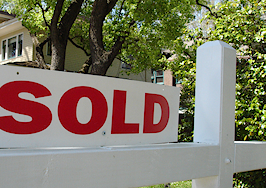- The Census Bureau takes its guess at the actual number of sales each month and multiplies them by 12, “annualizing.”
- Much more descriptive is the year-over-year figure, which compares sales to the same month last year -- the latest numbers show us down 1.6 percent year-over-year.
- Sales of 654,000 new homes as of July is a rate of construction only 2 percent of population -- 3 percent is considered healthier.
The general headline response to this week’s announcement of 654,000 sales of new homes in July (seasonally adjusted, annualized): Best Since 2007! New York Times: “The Housing Market Is Finally Starting To Look Healthy.”
The figure did beat forecasts for 590,000 homes. And of course, we didn’t sell that many in one month.
[graphiq id=”ba7PAhWsfMF” title=”Monthly New Home Sales in the United States” width=”600″ height=”666″ url=”https://w.graphiq.com/w/ba7PAhWsfMF” link=”http://trends.findthehome.com/l/2828/The-United-States” link_text=”Monthly New Home Sales in the United States | FindTheHome” ]
What’s annualization have to do with it?
In one of the worst data computations and presentations in all of economics, the Census Bureau takes its guess at the actual number of sales each month and multiplies them by 12, “annualizing.”
If you’d like to distort any short-term trend, or a blip into a big headline, multiply the number by 12.
Much more descriptive is the year-over-year figure, which compares sales to the same month last year.
How’s year-over-year looking?
By the year-over-year measure we are doing better, but only by about 15 percent in a volatile series.
To compare even that figure to conditions in 2007 is silly — sales of new homes did get worse from 2008-2012, but those were the worst years since the Great Depression.
To answer the recovery question, we need a metric better than a twelve-time multiple, or a comparison to disaster.
And here it is: new homes sold as a percent of population.
The population factor
From 1970 to the beginning of the false boom after 2000, U.S. sales of new homes were remarkably steady, between 400,000 and 800,000 annually.
That 30-year period included five recessions, corresponding to the lows in sales. In the recovery economies between recessions, new home sales were even more steady — near 700,000 each year.
In 1972, the population of the US was 213,000,000. So 700,000 new homes that year were not exceptional — the 1960s averaged 600,000 annually, housing for baby boom kids.
The population to new-home ratio: 3.3 percent.
Fast forward 15 years to 1987: another 700,000 homes, but population had grown to 236,000,000, a ratio of 3.0 percent. The ratio had fallen gently, but it should have: The fat part of the baby boom bulge was in the mid-1950s.
By 30 years later, at least half of the boomers had moved away from parents to their own homes, a natural demographic fade in demand.
Today, the U.S. comprises 319,000,000 of us.
Sales of 654,000 new homes as of July is a rate of construction of only 2 percent of population.
Sure, we overbuilt with phony subprime money from 2003 to 2006, but that excess was more than offset by the construction bust from 2007 through 2012.
Now we are under-built, especially in local markets with hot economies.
But not even under-building and a persistent “inventory shortage” explains this low ratio of new-builds to population, nor the pokey sales of existing homes.
In July (annualized again) we sold 5.39 million existing homes, a hefty number, but 1.6 percent below one year ago.
So what should we take from this?
Housing has not recovered. It is on track in some places to do so, gradually, but at this slope we are several years away — even a decade — from housing heat that should disturb the Fed into raising interest rates.
In fact, we are probably still fragile, one more reason for the Fed to go very slowly. And to doubt any “Housing Recovery!” headline that you see.
Lou Barnes is a mortgage broker based in Boulder, Colorado. He can be reached at lbarnes@pmglending.com.









